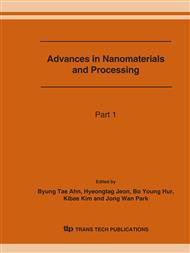p.927
p.931
p.935
p.939
p.943
p.947
p.951
p.955
p.959
Nano Composite Membranes of Branched Sulfonated Poly(Ether Ketone Sulfone) and SiO2 for Fuel Cell Application
Abstract:
Branched sulfonated poly(ether ketone sulfone) copolymer was prepared from1,1,1- tris(4-hydroxyphenyl) ethane, 4,4-difluorophenylsulfone, 3,3'-disodiumsulfonylbenzophenone (40 mol% of bisphenol A) and bisphenol A by polycondensation with the elimination of water in toluene and NMP at 160) in the presence of anhydrous potassium carbonate. Composite membranes were successfully cast from the control of organic polymer with SiO2 4-10 wt% of polymer in DMSO. The films were converted from the salt to acid forms with dilute hydrochloric acid. Organicinorganic composite membranes for operation in polymer electrolyte membrane fuel cells (PEMFCs) were characterized and cell-tested. The physico-chemical properties of all membranes were investigated their thermal properties, water uptake, DSC and thermogravimetric analyzer (TGA). Branched copolymer and nano composite membranes exhibit proton conductivities from 1.7x10-3 to 8.3x10-3 S/cm2, water uptake from 22 to 26%, IEC from 1.28 to 1.46 meq/g and methanol diffusion coefficients from 1.2x10-7 to 1.7x10-7 cm2/S.
Info:
Periodical:
Pages:
943-946
Citation:
Online since:
June 2007
Authors:
Price:
Сopyright:
© 2007 Trans Tech Publications Ltd. All Rights Reserved
Share:
Citation:


